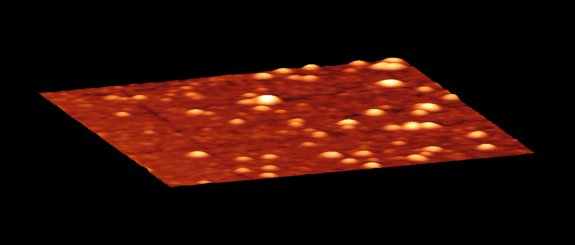Home > Press > Blowing bubbles on a nanoscale
 |
| A 3-D visualization of nanobubbles present on a hydrophobic surface. The bubbles have a diameter of only 50-200 nanometres and a thickness of 5-20 nanometres. |
Abstract:
Scientists are puzzled by the nanobubbles that can develop on surfaces under water. It should be impossible for them to exist but nevertheless they remain intact for hours. They are something of a mystery, yet it is possible to manipulate the development of these bubbles, according to PhD candidate Shangjiong Yang at the University of Twente. The bubbles can then, for example, be used to reduce flow resistance in liquids. Yang received his doctorate from the Faculty of Applied Sciences on 9 October.
Blowing bubbles on a nanoscale
Netherlands | Posted on October 15th, 2008If a water-repellent material is submerged in water, nanobubbles can develop on its surface: extremely small air bubbles with a diameter of 50-200 nanometres and a thickness of 5-20 nanometres. These bubbles are so small they cannot even be seen with a normal microscope and that is why they were not discovered until a few years ago.
According to existing theories, these bubbles should really not exist at all, as the pressure inside them is so great that the gas they contain should be pressed out within a fraction of a second. It is still not understood why these bubbles can remain intact for hours. Once it is possible to manipulate the formation and properties of these bubbles, a whole range of applications becomes possible. For example, the frictional resistance of flowing liquids is reduced by the bubbles, thus enabling them to be used as a lubricant in extremely narrow channels. This is of practical use in the development of the so-called ‘labs-on-a-chip': a whole laboratory set-up, reduced to the size of a chip. Before these bubbles can be employed in this way, however, we have to understand them better and be able to determine exactly where they should develop.
Production of nanobubbles
Yang demonstrated that electrolysis is a reliable method for controlling the production of nanobubbles. He discovered a way of influencing the formation and size of the bubbles by applying a voltage. He also researched several fundamental properties of the bubbles. After all, before you can use them you have to understand them. That is why he investigated the influence of temperature, gas concentration, the roughness of the surface and the surface treatment method on bubble formation. Yang made use of the Atomic Force Microscope (AFM) when carrying out his investigation. It is a microscope with a minuscule needle that moves over the surface (just like the needle of a record player) and monitors differences in height. This needle was used not only to investigate the outlines of the bubbles but also to manipulate them.
Information for the press
Shangjiong Yang (1980, Chongqing, China) carried out his PhD research with the specialist groups Physics of Fluids and Solid State Physics in the Faculty of Applied Sciences at the University of Twente. Professor Detlef Lohse and Professor Harold J.W. Zandvliet supervised his research.
This research forms part of the research programme run by the Foundation for Fundamental Research in Matter (FOM), and financed by the Netherlands Organisation for Scientific Research (NWO). The whole thesis (or just the abstract) is available in digital form.
####
For more information, please click here
Contacts:
Joost Bruysters
tel 0031 53 4892773
or
Wiebe van der Veen
tel 0031 53 4894244
Copyright © University of Twente
If you have a comment, please Contact us.Issuers of news releases, not 7th Wave, Inc. or Nanotechnology Now, are solely responsible for the accuracy of the content.
| Related News Press |
News and information
![]() Simulating magnetization in a Heisenberg quantum spin chain April 5th, 2024
Simulating magnetization in a Heisenberg quantum spin chain April 5th, 2024
![]() NRL charters Navy’s quantum inertial navigation path to reduce drift April 5th, 2024
NRL charters Navy’s quantum inertial navigation path to reduce drift April 5th, 2024
![]() Discovery points path to flash-like memory for storing qubits: Rice find could hasten development of nonvolatile quantum memory April 5th, 2024
Discovery points path to flash-like memory for storing qubits: Rice find could hasten development of nonvolatile quantum memory April 5th, 2024
Discoveries
![]() Chemical reactions can scramble quantum information as well as black holes April 5th, 2024
Chemical reactions can scramble quantum information as well as black holes April 5th, 2024
![]() New micromaterial releases nanoparticles that selectively destroy cancer cells April 5th, 2024
New micromaterial releases nanoparticles that selectively destroy cancer cells April 5th, 2024
![]() Utilizing palladium for addressing contact issues of buried oxide thin film transistors April 5th, 2024
Utilizing palladium for addressing contact issues of buried oxide thin film transistors April 5th, 2024
Announcements
![]() NRL charters Navy’s quantum inertial navigation path to reduce drift April 5th, 2024
NRL charters Navy’s quantum inertial navigation path to reduce drift April 5th, 2024
![]() Discovery points path to flash-like memory for storing qubits: Rice find could hasten development of nonvolatile quantum memory April 5th, 2024
Discovery points path to flash-like memory for storing qubits: Rice find could hasten development of nonvolatile quantum memory April 5th, 2024
|
|
||
|
|
||
| The latest news from around the world, FREE | ||
|
|
||
|
|
||
| Premium Products | ||
|
|
||
|
Only the news you want to read!
Learn More |
||
|
|
||
|
Full-service, expert consulting
Learn More |
||
|
|
||








